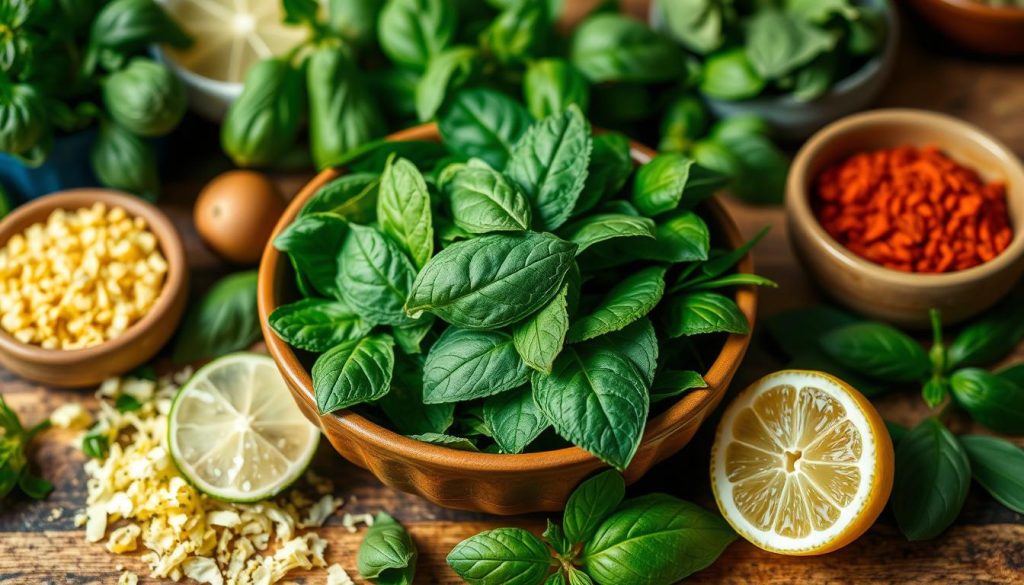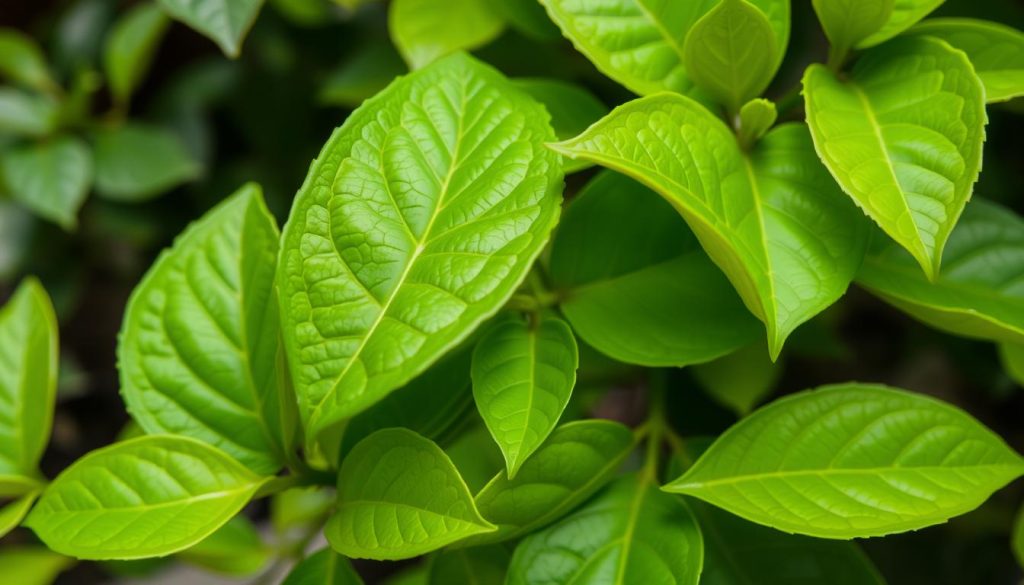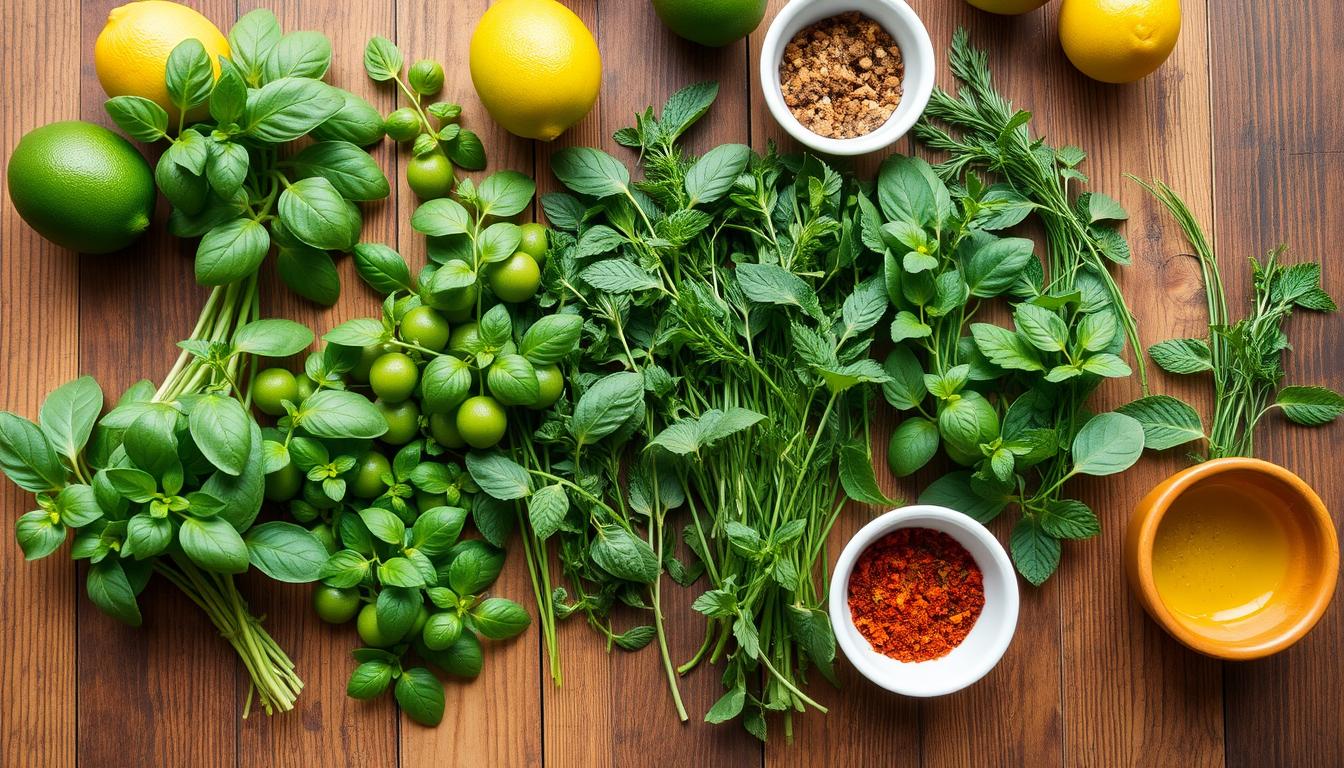Kaffir lime leaves are key in Asian cooking, like in Thai dishes. They add a unique citrus smell and taste. But sometimes, you might not find them. Knowing good substitutes is crucial.
This guide will show you the best kaffir lime leaves substitutes. They’ll help keep your dishes flavorful and zesty.
Looking for the right kaffir lime leaves substitutes can be exciting. It lets you make dishes that taste just as good as the originals. We’ll explore each substitute’s features and share tips on how to use them.
Understanding Kaffir Lime Leaves and Their Importance in Cooking
Kaffir lime leaves, also known as makrut lime leaves, are key in Thai cuisine. They’re found in dishes like tom yum goong and panang curry. Their unique flavor is a mix of citrus and a bit of bitterness, adding depth to recipes.
Their double leaf shape makes them versatile. You can use them in soups, salads, stir-fries, or even make aromatic powders. Their scent is a big part of many traditional dishes, not just in Thai but also Lao cuisine.
Though they have a strong taste, kaffir lime leaves have some limits. Makrut lime juice is too bitter and has too many seeds. Most people prefer using the fresh leaves. You can keep them in the fridge for a week or freeze them for longer.
Fresh kaffir lime leaves come from plants with thorns. This makes them fresher. While dried or frozen leaves are available, they’re not as intense as fresh ones. Using these leaves in your cooking can make your dishes better and celebrate their role in Southeast Asian cuisines.
| Aspect | Description |
|---|---|
| Flavor Profile | Citrusy, slightly bitter, and semi-tart |
| Common Uses | Soups, curries, stir-fries, and aromatic powders |
| Storage | Fresh for a week; freeze for longer life |
| Substitutes | Lime zest or lemon zest; not a direct replacement |
| Importance | Key in Thai and Lao cuisines, enhancing flavor profiles |
Why You Might Need a Kaffir Lime Leaves Substitute
Kaffir lime leaves are key in Thai and Asian cooking, adding a special citrus taste and smell. But, there are reasons for substituting kaffir lime leaves. They might be hard to find, which is a big problem outside Southeast Asia.
Trying to cook without them can make your favorite dishes taste off. These leaves can also go bad quickly, making you look for other options. Maybe you can’t eat them because of a diet or allergy.

Knowing why you might need a substitute helps you keep your dishes tasty. Even when ingredients are scarce, the right substitutes can save the day. This way, you can always make delicious food, no matter what.
Kaffir Lime Leaves Substitute Guide
Kaffir lime leaves are key in Thai cooking. They add a unique flavor and aroma to dishes. Knowing their role can help you substitute them when needed.
Key Characteristics of Kaffir Lime Leaves
Kaffir lime leaves are dark green and have a special shape. They smell like lime and lemon, with a hint of bitterness. When cooked, they release oils that boost the dish’s flavor.
They are tough, so you need to prepare them carefully. This can involve cutting or bruising them. This makes them perfect for soups, curries, and stir-fries.
Common Dishes Featuring Kaffir Lime Leaves
Kaffir lime leaves are a must in many dishes. They are a big part of Thai favorites like:
- Thai green curry
- Thai red curry
- Tom yum soup
- Soto ayam, popular in Indonesian cuisine
They also add flavor to dishes from Laos, Indonesia, and Vietnam. Their strong and zesty taste can make a dish stand out. Using them in traditional recipes can elevate the flavor and aroma.

Top Substitutes for Kaffir Lime Leaves
Looking for a good substitute for kaffir lime leaves can make your dishes better. Here are some great alternatives that offer similar tastes and smells.
Lime Zest: A Perfect Citrus Alternative
Lime zest is a great choice because of its citrusy taste and smell. Use one lime zest for every 4-5 kaffir lime leaves. It’s perfect for adding flavor to many dishes, making it a favorite in lime zest uses.
Lime Juice: The Liquid Option
Lime juice is a good substitute if you don’t have lime zest. Use one tablespoon of lime juice for one kaffir lime leaf. It’s great in soups, marinades, and dressings to add a tangy flavor.
Lemongrass: Bright and Zesty Flavor
Lemongrass has a fresh, citrusy, and herbal taste. For every 4-5 kaffir lime leaves, use 2-3 stalks of lemongrass. Chop or crush it to release its oils, enhancing soups and curries.
Herbal Mix of Basil, Mint, and Coriander
A mix of basil, mint, and coriander offers a unique flavor. Use one teaspoon of this mix for each kaffir lime leaf. It adds a fresh twist to your dishes.
Bay Leaves: Adding Depth to Dishes
Bay leaves are a reliable substitute for their ability to add depth. Use one bay leaf for each kaffir lime leaf, best in stews or soups. They blend flavors beautifully over time.
Lemon Zest: A Diametrically Opposed Twist
Lemon zest has a tangy flavor like lime zest. Use half a teaspoon of lemon zest to replace one kaffir lime leaf. It adds a different twist but keeps dishes lively.
Preserved Lemons: Unique Flavor Profile
Preserved lemons have a strong, briny taste like kaffir lime leaves. Use one tablespoon of preserved lemon, finely chopped, for one leaf. They’re amazing in cooked dishes.
How to Use Each Substitute Effectively
Using substitutes for kaffir lime leaves can make your dishes taste better. Knowing measurements for substitutes and using cooking tips for substitutes is key. Learn the right amounts of lime juice, zest, lemongrass, and more to get the flavors right.
Measurement Guidelines for Substitutes
Knowing how to substitute kaffir lime leaves is important. Here are some useful ratios:
- For lime zest, use ½ teaspoon to replace one fresh kaffir lime leaf.
- One tablespoon of lime juice can replace a single kaffir lime leaf.
- In soups and curries, use one chopped stalk of lemongrass for every three kaffir lime leaves.
- If using dried kaffir lime leaves, use the same amount, but remove them before serving as they can be tough.
- For a more nuanced flavor, add kaffir lime leaf powder in small amounts.
Cooking Tips for Best Results
To get the flavor you want, timing and technique are key. Here are some tips:
- Add lime zest or juice towards the end of cooking to keep their fresh flavors.
- For dried options like bay leaves or preserved lemon, add them early to let their flavors develop.
- Keep tasting your dish as it cooks, adjusting for any bitterness or tartness from the substitutes.
- Use lime zest in Western and Mediterranean recipes, with herbs like basil, to get Southeast Asian flavors.
- Try kaffir lime leaves in rice or seafood dishes to add unique herbal and citrus notes.
Where to Find Kaffir Lime Leaves and Its Substitutes
Looking for kaffir lime leaves can really boost your cooking. Knowing the difference between fresh and frozen leaves is key. This helps you pick the best for your recipes.
Fresh vs. Frozen: Pros and Cons
Choosing between fresh and frozen kaffir lime leaves has its perks:
- Fresh Leaves: They pack a strong flavor and aroma. Perfect for soups like tom yum goong and curries. You can find them in the fridge at Asian grocery stores.
- Frozen Leaves: They last longer and are easy to store. Though they might lose some flavor over time. Frozen leaves are great when fresh ones are hard to find.
Online Resources for Purchasing
Can’t find kaffir lime leaves locally? Online shopping is a good backup. Sites like Amazon and Asian ingredient-focused websites have them. Always check reviews and ratings for freshness. Some sellers also offer dried options, making them easier to find.
| Type | Flavor Intensity | Storage Method | Where to Buy |
|---|---|---|---|
| Fresh Kaffir Lime Leaves | High | Refrigerate for weeks; freeze for longer | Asian Grocery Stores |
| Frozen Kaffir Lime Leaves | Medium | Freeze for months | Online Retailers |
| Dried Kaffir Lime Leaves | Low | Store in a cool, dry place | Specialized Culinary Websites |
Conclusion
Understanding kaffir lime leaves is key to better flavors in your cooking. These leaves are essential in Thai kitchens but can be hard to find. Luckily, there are many substitutes that can add great taste to your dishes.
Substitutes like lime zest, lime juice, lemongrass, and fresh herbs can make your food taste amazing. Bay leaves, lemon zest, and preserved lemons also offer unique flavors. These options help keep your dishes full of life and aroma.
Using these substitutes well is important to keep your recipes true to their original taste. By following the right amounts and cooking methods, you can still enjoy great flavors even without kaffir lime leaves. This way, your meals stay delicious and fulfilling.
With these tips, you can keep exploring the world of Southeast Asian flavors. Your kitchen will become a place of wonderful smells and tastes, one dish at a time.
Source Links
- https://cookscrafter.com/kaffir-lime-leaves-substitutes/
- https://www.thespicehouse.com/blogs/news/what-are-makrut-lime-leaves?srsltid=AfmBOopKWPJWh3xGpuXpnsNvaEEwFLLON6R8hMx7sjov-PK69y-H29w3
- https://hot-thai-kitchen.com/kaffir-lime-leaves-101/
- https://www.saengskitchen.com/laofoodblog/kaffirlimeleaves
- https://www.simplysuwanee.com/kaffir-lime-leaves-and-substitute/
- https://thestonesoup.com/kaffir-lime-leaves-substitutes/
- https://www.mothersalwaysright.com/best-substitutes-for-kaffir-lime-leaves/
- https://www.thai-food-online.co.uk/blogs/thai-food-online-blog/kaffir-lime-leaves-guide?srsltid=AfmBOopvyQw4ZBDLjH6CJr-8sUBvLSiZvB0H8dVHDRVAgA9rjk8l1FtA
- https://gustomeadow.com/kaffir-lime-leaves-substitutes/
- https://www.mishry.com/the-best-kaffir-lime-leaves-substitutes
- https://www.thechefandthedish.com/post/what-are-kaffir-lime-leaves
- https://discover.texasrealfood.com/swap-and-savor/how-to-substitute-kaffir-lime-leaves-for-lime-zest
- https://www.wikihow.com/Use-Kaffir-Lime-Leaves
- https://www.spiceography.com/kaffir-lime-leaves-substitute/
- https://pupswithchopsticks.com/kaffir-lime-leaves/
- https://rachelcooksthai.com/kaffir-lime-leaves-bai-makrut/
- https://hungryinthailand.com/kaffir-lime-leaves/
- https://www.ispiceyou.com/blogs/news/lemon-grass-vs-kaffir-lime-leaves?srsltid=AfmBOoqpMilAx6tovzW3iwaoDTomwtQxVPuFQqbBNLaWcJ877a9pMJLe
